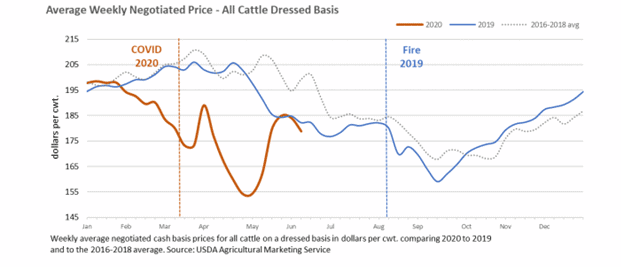American Cattle Ranchers and the Fight Against the Cattle Market Monopoly
Monopolies in the meatpacking industry is nothing new for American cattle ranchers.
Over the last several years, the price of live cattle has plummeted while the price of boxed beef has significantly increased. Last year, the USDA launched an investigation into the monopolization of the meat processing sector after a 2019 fire at a Tyson meatpacking plant in Kansas led to major supply disruption. In July 2020, the USDA released a report analyzing the market conditions before and after both the 2019 fire and the ongoing 2020 COVID-19 pandemic.


Read the full USDA investigative report here.
The report provided clear insight into how COVID-19 exacerbated the threat of meat market monopolization and the need for stronger regulations. In May 2020, the Department of Justice (DOJ) launched an investigation into the four largest meatpackers in the U.S. to determine if anticompetitive practices contributed to this stark imbalance.
Legislators and Livestock Groups Push for Cattle Price Transparency
Fast forward to May 2021, where there has yet to be an update on the DOJ findings. On May 17th, a bipartisan group of 16 lawmakers sent a letter requesting congressional updates on the investigation. On June 8th, another bipartisan letter signed by 51 lawmakers was sent asking for details on the outcome of the DOJ investigation.
During this time, six major livestock groups made major steps towards finding a solution by holding a closed-door meeting with individuals representing the U.S. Cattlemen’s Association, R-CALF USA, National Cattlemen’s Beef Association (NCBA), American Farm Bureau Federation (AFBF), National Farmers Union (NFU), and the Livestock Marketing Association (LMA). This landmark meeting laid the foundation for six key areas to focus on for meatpacking antitrust enforcement:
- Packer concentration
- Price transparency and discovery
- Packer oversight
- Packers and stockyard act enforcement
- Level of captive supply
- Packer capacity
Industry leaders also left with three key action items to help solve the cattle market monopoly issue:
- Expedite the renewal of USDA’s Livestock Mandatory Reporting (LMR), including formula base prices subject to the same reporting requirements as negotiated cash and the creation of a contract library.
- Request the DOJ issue a public investigation status report and as warranted, conduct joint DOJ and USDA oversight of packer activity moving forward.
- Encourage investment in and development of new independent, local, and regional packers.
These cattle groups stated that this historic meeting was just the start of their fight against the cattle market monopoly.
“This is just the beginning and a very good one, but there’s still work to be done.”
Larry Schnell, President of the Livestock Marketing Association.
A Step in the Right Direction for Meatpacking Antitrust Laws
The combination of these events has led to heavy legislative pressure to address this issue quickly and effectively. The most notable impacts at this time include:
- June 8, 2021 – The Optimizing the Cattle Market Act of 2021 is introduced in an attempt to “enable mechanisms for greater price discovery and transparency within the cattle market, while equipping producers with more tools and useful information to succeed.”
- June 11, 2021 – The USDA announces plans to unveil three proposed rules in the coming months to strengthen the Packers and Stockyards Act—an act created to protect against unfair trade and competition practices.
- July 9, 2021 – President Biden signs an executive order to promote competition among American small business owners, including initiatives to address ‘Product of USA’ labeling concerns and make it easier for farmers and ranchers to file and win claims against processors without fear of retaliation under the Packers and Stockyards Act.
- That same day, Ag Secretary Tom Vilsack announces $500 million from the America Rescue Plan funds will be allocated to expand meat and poultry processing in an effort to increase market options for family farmers and ranchers.
- July 30, 2021 – The nomination of Janie Simms Hipp for USDA General Counsel is confirmed by the U.S. Senate. During her nomination process, Hipp pledged to make cattle price transparency a top priority in her new role.
- August 5, 2021 – The USDA Agricultural Marketing Service announces efforts to improve transparency in cattle market prices through the release of two Market News reports. One shares national base price information of formula agreements and the other shows at what levels (price and volume) trade occurred across the weekly weighted average price for each purchase type (negotiated, negotiated grid, formula and forward contract).
- October 21, 2021 – The U.S. House Ag Committee voted unanimously to pass the bipartisan Cattle Contract Library Act to increase transparency on cattle markets and give ranchers more leverage in negotiations with packers.
- November 9, 2021 – A bipartisan group of senators introduce the Cattle Price Discovery and Transparency Act which would require the USDA establish mandatory minimum cash trade for each designated cattle region.
- December 8, 2021 – The House advances the Cattle Contract bill in a 411-14 vote to the Senate and extends livestock mandatory reporting in a 419-9 vote.
- December 9, 2021 – The USDA announces the Loan Guarantee Program to address meatpacker consolidation with a commitment of $100 million in guaranteed loans to expand meat processing capacity.
- December 10, 2021 – The White House releases findings that net profits for major meat processors experienced triple-digit growth since the start of the pandemic, contradicting the argument that higher input expenses are leading to rising meat costs for people at home.
“The growing momentum we’re seeing in the House and Senate behind addressing these critical concerns in the cattle markets is reflective of the urgency producers are feeling across the country. Extreme market volatility, unpredictable input costs, a shifting regulatory landscape, and natural crises like drought leave cattle farmers and ranchers with a growing list of threats to their continued financial viability.”
NCBA Vice President of Government Affairs Ethan Lane.
An alleged cattle tax in the infrastructure bill passed back in August 2021 or embedded into the Build Back Better Plan brought concern for many in the industry, but the rumor of a proposed methane tax on cattle has since been debunked.
This renewed spark of motivation to address the complex issue of monopolization in the cattle market shows promise—but there’s still work to be done. As an advocate for our nation’s hardworking cattle ranchers, AgAmerica stands behind these efforts and will continue to provide updates and financial resources to support the success of cattle ranchers across the nation.
Sign up for AgAmerica’s newsletter to stay informed on the latest trends in the agriculture industry.






